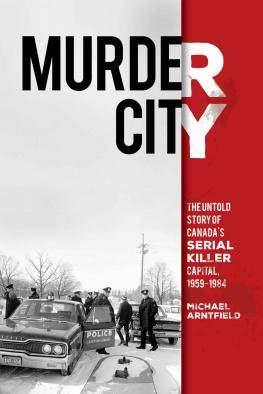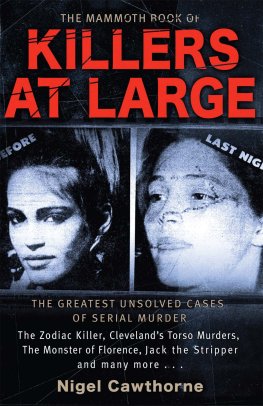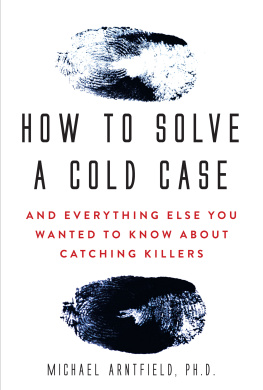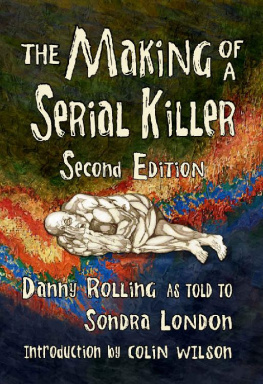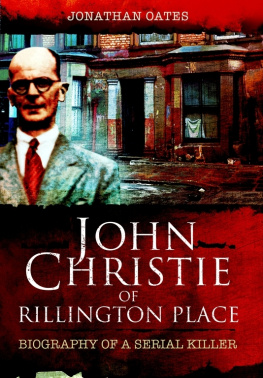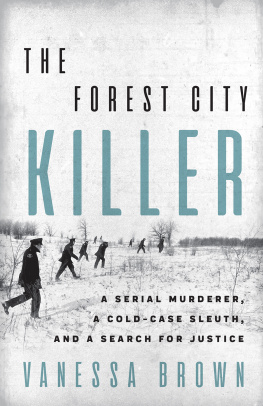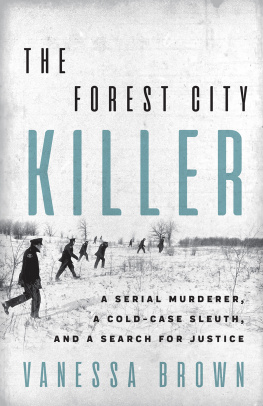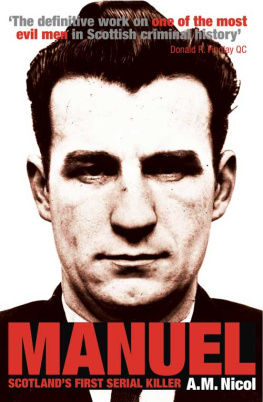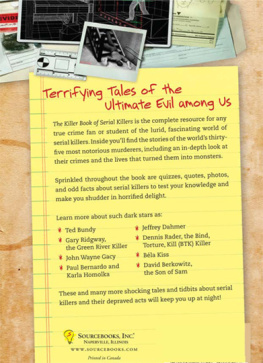MURDER CITY
The Untold Story of Canadas Serial Killer Capital, 1959-1984
Michael Arntfield, PhD
Research Assistant: Lee Mellor
Original Artwork: Nikolina M. Wallis
Cover Images: Courtesy of Western University Archives
Table of Contents
-Prologue
Kingdom Hall
-Chapter 1
Canadian Horror Story
Process-Focused vs.
Act-Focused Killers
- Chapter 3
Flashpoint: 1963-67
-Chapter 5-
Critical Mass: 1969
For the victims and their families,
and for the Dennis Alsops
Senior and Junior
who together carried the fire for over fifty years.
Acknowledgements
Its difficult to know where to start in terms of acknowledging all of the people who provided inspiration, support, and source material for this personally transformative bookmy personal Caine Mutiny . In writing this book I have been inspired by the remarkable bravery and resilience of many. Ironically, and for very different reasons, I have also been motivated by the indifference and incompetence of an unduly influential but woefully ineffectual handful of pretenders.
During the course of my research, which broadly transcends my own investigative police work, academic teaching, scholarly and forensic research pursuits, and media productions, I have either directly or indirectly met some truly remarkable people. The academic, scholarly, and scientific collaborators, supporters, and intellectual contributors are the most obvious. The soon-to-be Dr. Lee Mellorfriend, colleague, and stalwart research assistantis first up in this category, followed in short order by Dr. Eric Hickeya true luminary and the original public criminologistwhose wisdom and insight are truly unrivalled on a global scale. Moving on, Dr. D.J. Williams at Idaho State University, Dr. Jonathon Vance, Dr. Tim Blackmore, Dr. Kim Luton, and Dr. Regna Darnell at Western University, together with Dr. Marcel Danesi at the University of Toronto, all played enormous roles in seeing the vision for this book through to completion. Detective Ken Maines of the American Investigative Society of Cold Casesat once a sleuth and a forensic entrepreneur with a visionas well as Dr. John Olsson of the British Institute for Forensic Linguistics and Deneen Hernandez of the FBIs Forensic Cryptanalysis Unit also merit thanks, as do Dallas Drake of the Homicide Research Institute, Enzo Yaksic of the Multidisciplinary Collaborative on Sexual Crime and Violence, and Jeffrey Christian, an independent researcher and hired-gun armchair sleuth in the field of Canadian crime history, genealogy, and victimology. Other experts and trailblazers whose work is cited hereDavid Canter and D. Kim Rossmoalso deserve recognition for their calling as pioneers in helping to try to solve serial cases and unsolved crimes. Their research has played a significant role in advancing a number of the cases discussed in this book.
I also need to acknowledge the extraordinary support and commitment of countless police officers of varying rank, with whom I have worked and who have supported not only this book but also a wider vision regarding cold case closure in Canada. More specifically, from the London Police, I acknowledge Sergeant Dave Staines (ret.), Detective Constable Zaia Lazar (ret.), Sergeant Dave Gilmore, and from the OPP, Sergeant Barry Ruhl (ret.) Detective Constable John Veilleux, and Detective Shawn Mather. From the RCMP, I offer special thanks to Assistant Commissioner Cal Corley (ret.) and Staff Sergeant Gerard MacNeil (ret.), as well as Corporal Bob Basanti and Inspector Tino Liokossis, all of whom were early adopters and huge supporters of my teaching and research, first undertaken while still a cop myself. Id also like to recognize and offer specific thanks to Detective Chris Neal and others with the Toronto Police Cold Case Unit for their tireless efforts and appreciation of my work. Beyond this list of names, there are another two-dozen officers between five police services I would like to thank and whose stories Id also like to one day tell, as well as several Crown prosecutors who asked not to be mentioned by name for fear of predictable bureaucratic blowback. By extension, the crime reporters of the world, including Jane Sims at the London Free Press, who I credit with coining the term the Truscott hangover used in Chapter Two of this book, all deserve recognition for keeping public interest in these cases alive.
I also want to acknowledge and thank the extraordinary families who have met with me during my research and whose perseverance in the face of horrific tragedy, dashed hopes, questionable investigations, and sense of abandonment is the true inspiration for this book. The Jensen, White, English, and Awcock families in particular are remarkable inspirations, and along with Dennis Alsop, are the real heroes of this dark age in London and Canadian history alike. I met a number of these very brave and tenacious people through Dennis Alsops sonDennis Jr.who is fulfilling his fathers tireless wish for closure and justice, and has done a great public service in the process. I also met some of them through the work done by the studios and networks affiliated with the production of the internationally syndicated mini-series To Catch a Killer . Further, Niki Wallis, who single-handledly captured the true essence and veritable innocence of those victims whose families, for the most part, Ive met over recent years deserves tremendous gratitude for her vision, compassion, and acumen.
Lastly, the wonderful and dedicated students, faculty, and staff who volunteer their services, scholarship, and insights as part of my Cold Case Society at Western University deserve special thanks, especially my 2IC, Professor Neisha Cushing, my virtual assistant Brikena Qamili, and Barry Arnott with the Western University Archives Collection. Some of the students attached to the Society aspire to go on into policing, the practise of law, and victim services and counselling. Some simply have a passion for history and social justice. Others are logicians inevitably fascinated by the puzzles presented by cold cases and the challenge of building a better mousetrapoften at the expense of their own studies or personal lives. Regardless of what drives them, they are truly an inspiration and demonstrate how future generations of knowledge users will help shape the discourse of criminal investigation and improved professionalization of policing in Canada.
Lastly, with respect to Dennis Alsop Sr., my sentiments are perhaps best summarized with the words of epic crime novelist James Ellroy. In eulogizing Jack Webb ( Dragnet s iconic Joe Friday) in the revised 2005 edition of the Los Angeles crime anthology The Badge , he affectionately laments that he kicked too soonI never got a chance to thank him. I never got a chance to say, you got me hooked, I just followed your lead. While dying at age 92 is not really too soon in the grand scheme of things, the point is that I never had the chance to meet Dennis Alsop, something I regret. If I had, I would have told him that this is his book as much as mine, just as it is the book of any real cop who ever stuck with a case in spite of the odds and even after being told to drop it and move on. Theres not too many of them left.
With thanks,
Michael Arntfield, PhD
-Prologue
Kingdom Hall
The angels will ferret him out.
- Jehovahs Witness Overseer Arthur Powley, 1966
Slouching back behind the wheel of a 57 Ford Meteor, he lay waiting. Closing time was 6:00 p.m., but nightfall was already half an hour past, the streets of a sleepy town devoid of witnessessitting eerily still at the edge of infamy.
The darkness and the cold was proof positive of a typical February night, but proof positive also of something else: his wait was over at last. There was no more putting it off. The mask of normalcy and conformity he had worn for so long would finally be removed to unveil the grotesque aberration that lay beneath. The conditions were too optimal not to act, to not follow his fiendish calling. Tonight would be the night he would surrender to the obsessions that for so long had consumed himto the dark forces that had tormented him.
Next page
